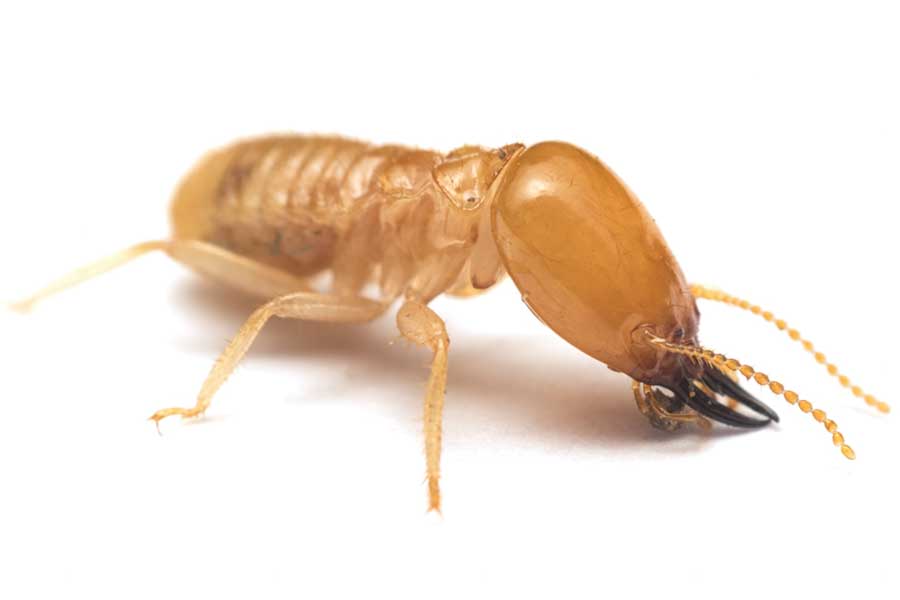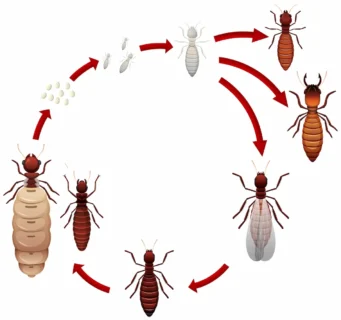
Termites look similar to ants, but there are some differing characteristics. They encompass a variety of species, each with unique appearances. Despite this diversity, there are several unifying physical traits among termites:
- Sizes of termites span from ¼ to ½ inch.
- Termite colors vary based on their caste, ranging from off-white to dark brown.
- Their bodies are segmented into three parts: a head, thorax, and abdomen.
- They possess six legs and straight antennae.
- The reproductive members of the species, known as swarmer termites or alates, are characterized by their wings.
Subterranean Termite Appearance
The most common type of termite in Mid-South TN to look out for is the subterranean termite. Subterranean termites are distinguished by their off-white to dark brown or black coloring. This wide spectrum of coloration among subterranean termites is directly related to their varied roles within their colonies.
Other characteristics to look for include:
- Size: ⅛ to 1 inch
- Legs: Six
- Wings: Alates or swarmers only
- Antennae: Two straight antennas

Termite Caste Characteristics
Termite appearance also differs between their colony ‘castes,’ which are roles they’re essentially born with. The structure of a termite colony is defined by three principal castes, each with a specific appearance and role:
- The majority of the colony is composed of workers, depicting an off-white to creamy hue.
- Soldier termites are recognizable by their large, dark heads and pronounced mandibles, often mistaken for ants.
- Alates, or swarmers, are the colony’s reproductive members, varying in color but uniformly winged, with these wings eventually being shed.
Termite ‘Job Assignments’ or Roles
When it comes to figuring out who does what in a termite colony, how does a termite end up as a worker, soldier, or reproductive? It depends on the social and environmental signals within the colony, a bit like a community working together to decide who’s best for each job. And the most interesting part? Termites can potentially switch roles if the colony’s needs change — it’s all about teamwork and adaptation.
What is the Life Cycle of a Termite?
Despite their destruction, termites have remarkable journeys through life. These little critters lead a complex and structured existence, playing specific roles within their colonies.
Termite species have the following life cycle:
- Male and female reproductives will mate and establish a new colony.
- The queen termite lays the eggs she has been producing.
- Larvae will hatch from the eggs and become nymphs.
- The nymphs will continually molt up to three times before reaching maturity.
- When mature, the termite will be assigned a caste, which is a specific role within a colony.

Let’s break it down even further:
- The termite life cycle kicks off the reproductive termites (also known as alates or swarmers), taking flight to create new colonies.
- Once they’ve found the perfect spot, the male and female alates cozy up, discard their wings, and settle down to become the new king and queen of their colony.
- Here, the queen gets down to business, laying an impressive number of eggs (sometimes up to 30,000 a day).
- These eggs hatch into larvae, which we call nymphs.
- These nymphs go through a transformation called molting, where they shed their skin up to three times as they mature.
Termite Life Spans Within a Colony
Now, how long do termites live? Well, it varies. Your average worker or soldier termite has a two-year lifespan. However, reproductives (alates) can live for a solid four years. But the queen, the heart of the colony — she’s a real survivor. And with the right conditions, the queen can live in her colony for at least two decades!
What to Do If You Spot Termites In Your Home
Due to their elusive nature, termites pose a significant risk, often going unnoticed as they inhabit the structure of homes. Spotting termites directly is rare, emphasizing the importance of professional intervention for proper identification.
So if you ever find signs of termites around your property, remember that they’ve got quite an organized setup. But worry not! That’s where your helpful neighborhood termite control experts at Inman-Murphy, Inc. come in. We’ll make sure that the life cycle of termites doesn’t continue in your home. Let’s keep your sanctuary safe from termite damage!
The termite exterminators at Inman-Murphy, Inc. are equipped to inspect your property meticulously, ensuring the accurate detection of termites present.
Call us today for a free service quote!
Back to Termite Identification
